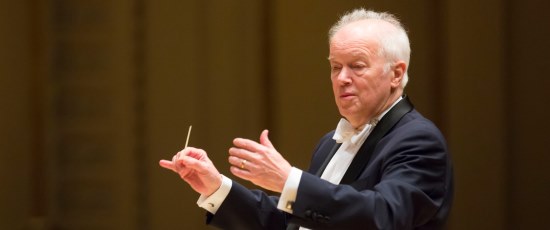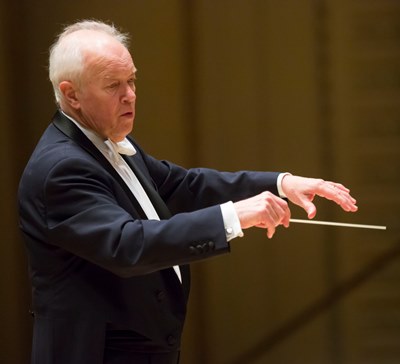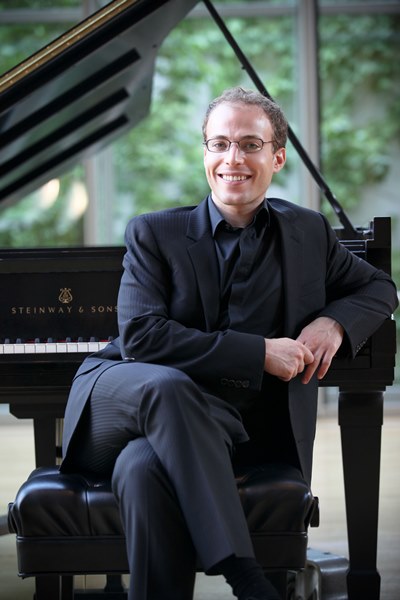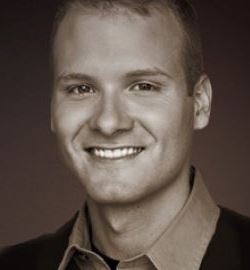Conductor Edo de Waart, in a hero’s return, guides CSO to the classical heart of Brahms
 Review: Chicago Symphony Orchestra conducted by Edo de Waart; Orion Weiss, piano. March 26 at Orchestra Hall.
Review: Chicago Symphony Orchestra conducted by Edo de Waart; Orion Weiss, piano. March 26 at Orchestra Hall.
By Lawrence B. Johnson
It was a little more than two years ago, with the Chicago Symphony Orchestra gearing up for a major Asia tour, that Dutch conductor Edo de Waart stepped in for ailing music director Riccardo Muti to lead a ringing performance at Orchestra Hall of Beethoven’s Symphony No. 3 (“Eroica”), a key component of that impending tour.
Then he stayed around for a second week to lead Brahms’ Fourth Symphony and Mozart’s Symphony No. 41 in C (“Jupiter”) — and subbed again last season for Vladimir Jurowski in an all-Strauss program. How handy that de Waart, 73, music director of the Milwaukee Symphony Orchestra, lives just up the way.
In a pair of concerts March 26 and 28, de Waart was back on the CSO podium — this visit scheduled! — for the second time since that heroic pre-Asia effort, presiding over Brahms’ Symphony No. 3 in F, again music from deep within the Classical vein, though composed some 80 years after the “Eroica.” And again the result was a finely wrought performance that showcased the Chicago Symphony at its patrician best.
 De Waart brought to Brahms’ elegantly crafted, indeed deceptively intricate Third Symphony both a poetic sensibility and a clear sense of structural plan. If there is little in common between the third symphonies of Beethoven and Brahms, it might at least be said that the animation and technical rigor of Beethoven’s finale seem to pervade the whole of Brahms’ symphony. And de Waart certainly captured that esprit while managing the details with insight and ease.
De Waart brought to Brahms’ elegantly crafted, indeed deceptively intricate Third Symphony both a poetic sensibility and a clear sense of structural plan. If there is little in common between the third symphonies of Beethoven and Brahms, it might at least be said that the animation and technical rigor of Beethoven’s finale seem to pervade the whole of Brahms’ symphony. And de Waart certainly captured that esprit while managing the details with insight and ease.
Broadly speaking, Brahms’ Third Symphony bookends two interior movements of chamber-like intimacy with grander designs in the opening movement and finale. And by the same token, that outer framework spotlights the string choir whereas the ruminative inner movements — neither of them cast in the propulsive mode of a scherzo – shift the focus to woodwinds and French horns.
Observing restrained tempos throughout, de Waart drew burnished, full-bodied sound from the CSO strings and allowed the wind players to bring real character to the conversations that illuminate the core of this symphony. Unlike Brahms’ First and Second Symphonies, which conclude in sunny triumph, the Third ends as if with a sigh – with the lyrical poise of Mozart and Schubert rather than the affirmation of Beethoven. De Waart and the CSO rounded off this eloquent music with sparkling gentleness, but also with a sense of inevitability and completeness that stirred a notably quiet audience to lusty approval.
 Classicism ruled de Waart’s program, which also featured Mozart’s Piano Concerto No. 25 in C with soloist Orion Weiss. Though not played as much as Mozart’s “other” C major concerto, the ever-popular No. 21, the work at hand is in fact Mozart at his most imaginative, disciplined and rewarding. From spare, simple material, the concerto flowers in to something of subtle beauty, deeply personal and quietly breathtaking.
Classicism ruled de Waart’s program, which also featured Mozart’s Piano Concerto No. 25 in C with soloist Orion Weiss. Though not played as much as Mozart’s “other” C major concerto, the ever-popular No. 21, the work at hand is in fact Mozart at his most imaginative, disciplined and rewarding. From spare, simple material, the concerto flowers in to something of subtle beauty, deeply personal and quietly breathtaking.
Weiss, 33, who grew up in Iowa and Ohio, made his debut with the Cleveland Orchestra as a teenager while studying at the Cleveland Institute of Music. He later became a protégé of Emanuel Ax at Juilliard. There was something paradoxical about his Mozart, which was incisive almost to the point of studiousness and yet in that very concentration irresistibly engaging. I couldn’t help wondering if that’s how Beethoven, the pianistic lion of Vienna before his hearing failed him, might have played Mozart.
But the playing was also as fluent as it was crisp, with a discursive first-movement cadenza that verged on the rhapsodic. The invention on display in the 25th Piano Concerto extends from keyboard to orchestra as Mozart intertwines piano and woodwinds through fleeting conversations made from thematic bits. Weiss and de Waart might have been duo pianists, so closely attuned were they in tossing ideas from soloist to ensemble and back.
 The concert began with a vibrantly orchestrated tone-picture titled “Nocturne,” composed by the young Florida native Michael Ippolito. On his website, the composer cites a 1940 painting of the same name by Joan Miró – with their “fantastical figures and swirling lines” – as the inspiration for “Nocturne.”
The concert began with a vibrantly orchestrated tone-picture titled “Nocturne,” composed by the young Florida native Michael Ippolito. On his website, the composer cites a 1940 painting of the same name by Joan Miró – with their “fantastical figures and swirling lines” – as the inspiration for “Nocturne.”
Ippolito also acknowledges obeisance within the work to Debussy, Bartók and Chopin. All of that is quite evident in a 10-minute piece fashioned with impressive flair from a very conservative harmonic palette. De Waart and the CSO gave Ippolito’s music a colorful go, and the composer was present to share in an appreciative ovation.
Related Links:
- Preview of Chicago Symphony’s complete 2014-15 season: Read it at ChicagoOntheAisle.com
- Look ahead at CSO’s 2015-16 season: Details at ChicagoOntheAisle.com

